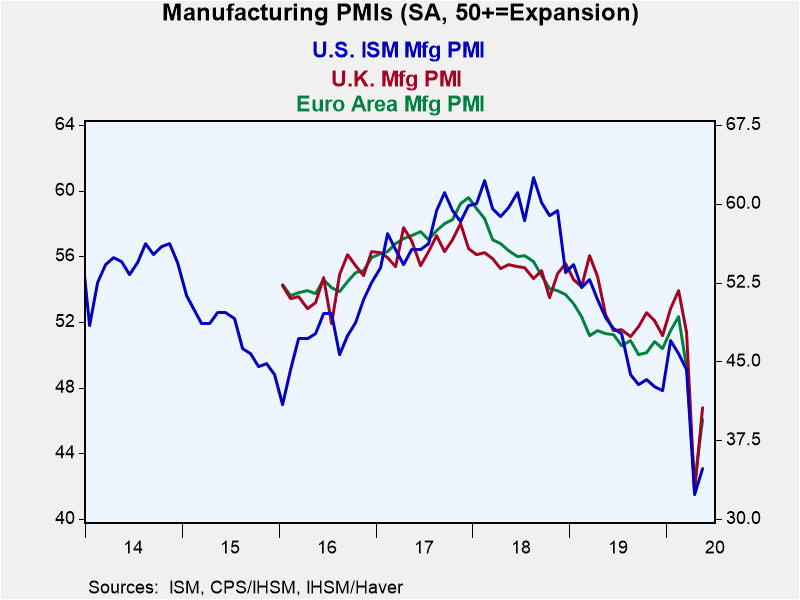 Global| Jun 01 2020
Global| Jun 01 2020Globally Manufacturing PMIs Rebound; A Bounce That Signals More Than It Refreshes
Summary
Manufacturing PMIs rose on broad front in May. Among those listed in the table, only three countries Japan, Taiwan and South Korea showed further manufacturing deterioration. China has been so weak so persistently that its very modest [...]
 Manufacturing PMIs rose on broad front in May. Among those listed in the table, only three countries Japan, Taiwan and South Korea showed further manufacturing deterioration. China has been so weak so persistently that its very modest 50.7 diffusion reading is a top ten percentile reading for China and a 50th percentile queue standing. And despite increases in PMIs this month, the queue standings remain extremely weak across the board with China as the only exception.
Manufacturing PMIs rose on broad front in May. Among those listed in the table, only three countries Japan, Taiwan and South Korea showed further manufacturing deterioration. China has been so weak so persistently that its very modest 50.7 diffusion reading is a top ten percentile reading for China and a 50th percentile queue standing. And despite increases in PMIs this month, the queue standings remain extremely weak across the board with China as the only exception.
The sequential data still show the preponderance of trends moving lower. This month's rebound has not yet reversed trends, at least not statistically. But this is a harbinger of where things are going. The levels of the PMIs are still extremely low; this is not a decisive bounce. But what is decisive is that this is an artificially induced recession that is now being unwound and the unwinding will continue.
Are there risks? There are risks. But this is the early stage of the turn and this is going to progress. This month is a watershed much more that it is a demonstration of strength. There is still is not strength, but the water is now going to flow in a different direction. It will gain momentum. There is going to be improvement. And at some point, the improving trends might be at risk again, but that risk is not here or now. That is something that still lies ahead. For now, global recovery seems to be in gear.
While this seems to be the start of a global recovery, there is a deep hole to dig out of. Conditions are not going to change overnight. In fact, the biggest uncertainty is no longer about the timing of recovery because we now seem to have established that, but the speed of the recovery. How fast will growth snap back how fast will manufacturing come back? How fast will the services sector recover? And then attention will turn to the next step in the process which is how fully will all of this come-back? The speed and the completeness of the recovery process are the two most contentious issues now. Countries are getting past the notions that reopening is too dangerous or it is too soon and they are doing it. But many challenges remain.
Some analysis has begun to focus on the potential for a 90% recovery. On the face of it, 90% may sound not too bad. But if the unemployment rate is TEN percentage points higher than it was at the lows, that will not be good. A 90% recovery would be a recovery with many sectors back up and running and going full tilt. But to put the overall rebound at 90%, there are other sectors that would be at 70% or maybe less and those services sectors have been talked about. The restaurant and hotel businesses, the airlines and the movie theaters, amusement parks and so on all face significant challenges. When there are sectors that come back a lot less than 90%, there is a real problem since many of these are labor intensive businesses. So the impact on unemployment could turn out to be much worse. And all that is simply ignoring that there have been enterprises that have been run out of business and will not be coming back. Small businesses some peoples' or family's life's work is gone. For many the future will never ever be anything like ‘the same.'
Recovery is now in train. But it will have an uneven speed. It is not clear how world trade comes back because there is still trade conflict and other geopolitical conflicts that could spill over into trade. The Baltic dry index is not yet stirring or showing any sign of turnaround or revival in global trade flows. Once recovery is more fully established, there might be periods in which it seems to progress faster and others when is seems slower. That will be the nature of the recovery process that is what is coming next.
Robert Brusca
AuthorMore in Author Profile »Robert A. Brusca is Chief Economist of Fact and Opinion Economics, a consulting firm he founded in Manhattan. He has been an economist on Wall Street for over 25 years. He has visited central banking and large institutional clients in over 30 countries in his career as an economist. Mr. Brusca was a Divisional Research Chief at the Federal Reserve Bank of NY (Chief of the International Financial markets Division), a Fed Watcher at Irving Trust and Chief Economist at Nikko Securities International. He is widely quoted and appears in various media. Mr. Brusca holds an MA and Ph.D. in economics from Michigan State University and a BA in Economics from the University of Michigan. His research pursues his strong interests in non aligned policy economics as well as international economics. FAO Economics’ research targets investors to assist them in making better investment decisions in stocks, bonds and in a variety of international assets. The company does not manage money and has no conflicts in giving economic advice.






